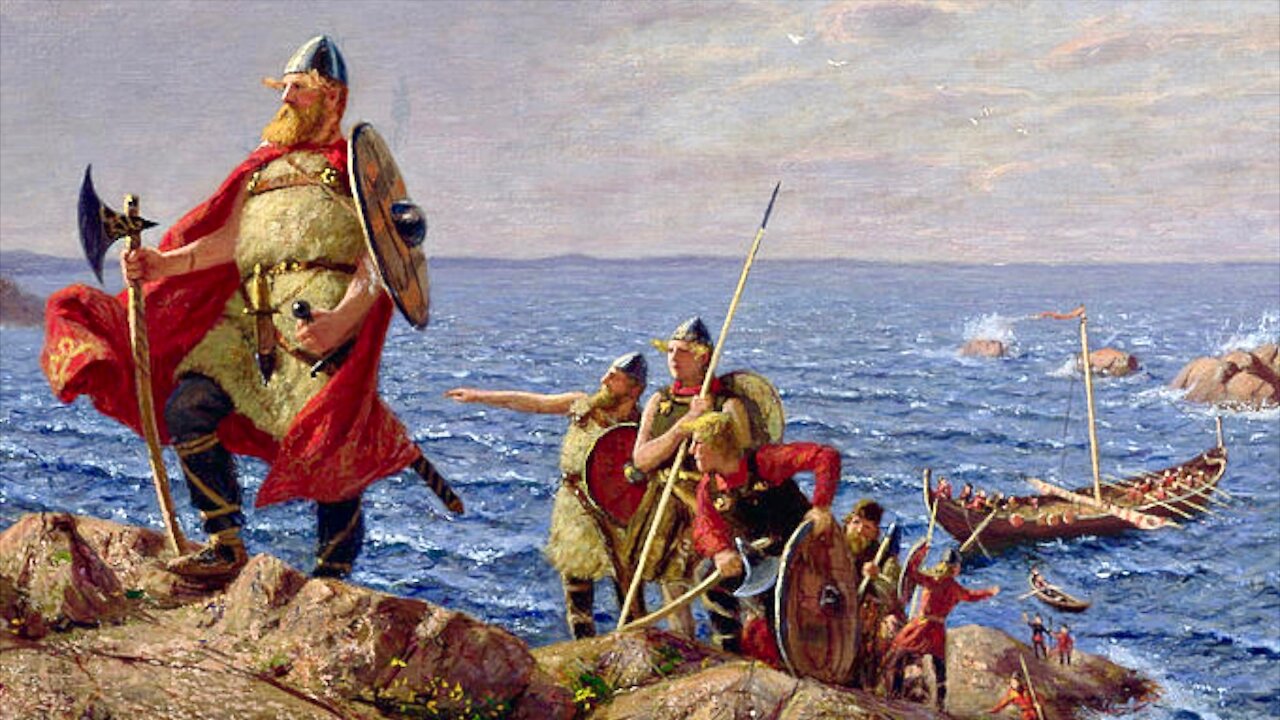Premium Only Content

Lost American Viking Settlement Discovered By Space Archaeologists Using Satellite Imagery
Discovery Could Rewrite History of Vikings in New World. Guided by ancient Norse sagas and modern satellite images, searchers discover what may be North America's second Viking site. Archaeologists have unearthed a stone hearth that was used for iron-working, hundreds of miles away from the only other known Viking site in North America. POINT ROSEE, Canada- It’s a two-mile trudge through forested, swampy ground to reach Point Rosee, a narrow, windswept peninsula stretching from southern Newfoundland into the Gulf of St. Lawrence. Last June, a team of archaeologists was drawn to this remote part of Canada by a modern-day treasure map: satellite imagery revealing ground features that could be evidence of past human activity.
The treasure they discovered here—a stone hearth used for working iron—could rewrite the early history of North America and aid the search for lost Viking settlements described in Norse sagas centuries ago.
To date, the only confirmed Viking site in the New World is L’Anse aux Meadows, a thousand-year-old way station discovered in 1960 on the northern tip of Newfoundland. It was a temporary settlement, abandoned after just a few years, and archaeologists have spent the past half-century searching for elusive signs of other Norse expeditions.
“The sagas suggest a short period of activity and a very brief and failed colonization attempt,” says Douglas Bolender, an archaeologist specializing in Norse settlements. “L’Anse aux Meadows fits well with that story but is only one site. Point Rosee could reinforce that story or completely change it if the dating is different from L’Anse aux Meadows. We could end up with a much longer period of Norse activity in the New World.”
The site of the discovery, hundreds of miles south of L’Anse aux Meadows, was located by archaeologist Sarah Parcak, a National Geographic Fellow and “space archaeologist” who has used satellite imagery to locate lost Egyptian cities, temples, and tombs.
Last November, TED awarded Parcak a $1 million prize to develop a project to discover and monitor ancient sites. This latest discovery in Newfoundland—supported, in part, by a grant from the National Geographic Society—demonstrates that her space-based surveillance can not only spy out artifacts in barren desert landscapes, but also in regions covered by tall grasses and other plant life.
Parcak led a team of archaeologists to Point Rosee last summer to conduct a “test excavation,” a small-scale dig to search for initial evidence that the site merits further study. The scientists unearthed an iron-working hearth partially surrounded by the remains of what appears to have been a turf wall.
The archaeologists don’t yet have enough evidence to confirm that Vikings built the hearth. Other peoples lived in Newfoundland centuries ago, including Native Americans and Basque fisherman. But experts are cautiously optimistic.
“A site like Point Rosee has the potential to reveal what that initial wave of Norse colonization looked like not only for Newfoundland but for the rest of the North Atlantic,” says Bolender.
Music: From Scales to Feathers Mix (Thirsty Lizard Mix) by Dhruva Aliman
Amazon- https://amzn.to/2Mgr7pg
https://music.apple.com/us/artist/dhruva-aliman/363563637
https://dhruvaaliman.bandcamp.com/album/the-wolf-and-the-river
http://www.dhruvaaliman.com/
Spotify - https://open.spotify.com/artist/5XiFCr9iBKE6Cupltgnlet
#history
#archeology
#interesting
-
 0:20
0:20
cricketgee
3 years ago $18.09 earnedAmerican bully doesn't respect personal space
23.5K62 -
 1:28
1:28
WPTV
3 years agoCompany announces large-scale space satellite facility in Florida
44 -
 5:53
5:53
One America News Network
3 years agoTipping Point - John Rossomando - Russia Shoots Down Satellite, Causing Space Debris
3767 -
 0:06
0:06
HTRogotski
3 years ago $0.01 earnedLOST IN SPACE " ROBOT "
36 -
 LIVE
LIVE
Dr Disrespect
5 hours ago🔴LIVE - DR DISRESPECT - MARVEL RIVALS - GOLD VANGUARD
4,480 watching -
 1:42:21
1:42:21
The Quartering
5 hours agoTrump To INVADE Mexico, Take Back Panama Canal Too! NYC Human Torch & Matt Gaetz Report Drops!
42.5K29 -
 2:23:15
2:23:15
Nerdrotic
5 hours agoA Very Merry Christmas | FNT Square Up - Nerdrotic Nooner 453
23.6K3 -
 1:14:05
1:14:05
Tucker Carlson
5 hours ago“I’ll Win With or Without You,” Teamsters Union President Reveals Kamala Harris’s Famous Last Words
88.8K240 -
 1:58:31
1:58:31
The Dilley Show
5 hours agoTrump Conquering Western Hemisphere? w/Author Brenden Dilley 12/23/2024
75.6K12 -
 1:09:59
1:09:59
Geeks + Gamers
6 hours agoSonic 3 DESTROYS Mufasa And Disney, Naughty Dog Actress SLAMS Gamers Over Intergalactic
47.8K9